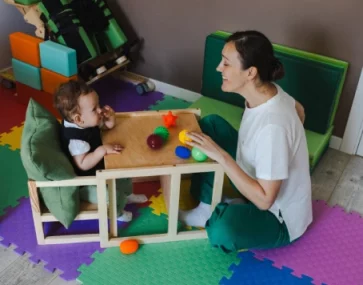Kids- every parent imagines them running around, talking endless things, doing both mischievous and health-melt activities, then going to school, doing their small to-small daily stuff and growing with time. Although, this picture-perfect scenario can not be the same in every household. For a few parents, dealing with their children who have neurological conditions may be a little challenging.
Children with Cerebral Palsy, Autism, sensory issues, motor delays, and many other conditions find it difficult to perform day-to-day occupations, meaning activities such as self-feeding, bathing, showering, getting up and down, moving around, etc. Occupational therapy(OT) may come of great help in these cases.
Parents, this article is all about occupational therapy for children. Reading this till the end will enrich you with the knowledge of- what occupational therapy is, How occupational therapists work, How this therapy can help, and the signs that indicate your child may need OT?
Let’s begin!
What Is Occupational Therapy?
Occupational therapy is a special type of therapy that focuses on helping children overcome challenges and reach their full potential. This therapy takes a holistic approach, considering both their physical and mental well-being.
Occupational therapy sessions are designed to support children to become more independent, confident, and capable of doing daily lives. The therapist here works consistently with the child along with the parents or caretakers to achieve the set goals.
In occupational therapy for kids, everyday activities are used as therapeutic tools to address their physical, mental, developmental, and emotional issues. In short, this therapy aims to help the child as a whole, rather than focusing only on a specific injury or disability.
How Do Occupational Therapists Work?
Occupational therapists have many various tasks and responsibilities. First, they evaluate the primary condition of the kids and figure out what they need help with. After the evaluation and asking several questions about the medical history, behavioral traits and so many things they try to understand the root cause of the problem. Later on, they create a customized therapy plan to treat the kid and help him/her reach specific goals.
These therapists also teach patients and their caregivers how to use special equipment that can help the kids even at home. The therapists keep track of the progress and write reports to show how they’re doing. Occupational therapists can work in different places like hospitals, private practices, schools, or with elderly people.
How Does It Help Children?
Children may benefit from occupational therapy in various situations. Here are some examples:
Children with autism: OT can be helpful for children with autism. Autistic children have sensory issues, such as sensitivity to touch or sound. This therapy can assist them in managing and coping with these sensitivities.
Poor handwriting: Occupational therapy supports children who struggle with handwriting. OT can improve their fine motor skills, hand-eye coordination, and overall writing abilities.
Toilet or self-feeding training: Occupational therapy is equally beneficial for children who need assistance with toilet training or learning self-feeding skills. Therapists can give guidance, strategies, and activities to make learning easy and fun.
Fine motor skill difficulties: Some children may have challenges with their fine motor skills, such as handling small objects or performing precise movements. OT can focus on enhancing these skills, enabling children to perform tasks like using utensils, buttoning clothes, or manipulating objects more effectively.
Learning basic tasks: Occupational therapy emphasizes developing essential abilities to perform basic activities such as dressing, bathing, brushing teeth, and other self-care tasks.
What Are The Signs That Indicate Your Child Might Need Pediatric Occupational Therapy?
Delay in achieving developmental milestones: If your child is not meeting age-appropriate milestones or lacks social and play skills, you might need to see a therapist.
Avoiding eye contact: This is a significant sign that should not be ignored, as it may indicate underlying difficulties.
Sensory processing difficulties: If your kid has trouble with postural control, motor planning, sensitivity to sounds or textures, or poor fine motor skills like writing, he/she might need OT.
Gross motor skill difficulties: Children with issues regarding movement, balance, and complex motor tasks, may need OT.
Fine motor skill difficulties: Challenges with tasks that require small muscle movements, such as holding a pencil, using scissors, or buttoning clothes, also need attention from a therapist.
Self-care challenges: Difficulty with activities like brushing teeth, dressing, feeding themselves, or using the toilet independently, etc indicate the kid may need OT.
Bottom Line
We hope this article has helped you get valuable information about pediatric occupational therapy. Remember, early intervention is key to addressing these challenges and promoting your child’s development and well-being.
Therefore don’t wait! If you find any alarming sign that you believe is hindering the developmental growth of your child, don’t hesitate to reach out to our therapeutic center for effective occupational therapy in Dubai.
Book a consultation with one of our experienced occupational therapists today!






